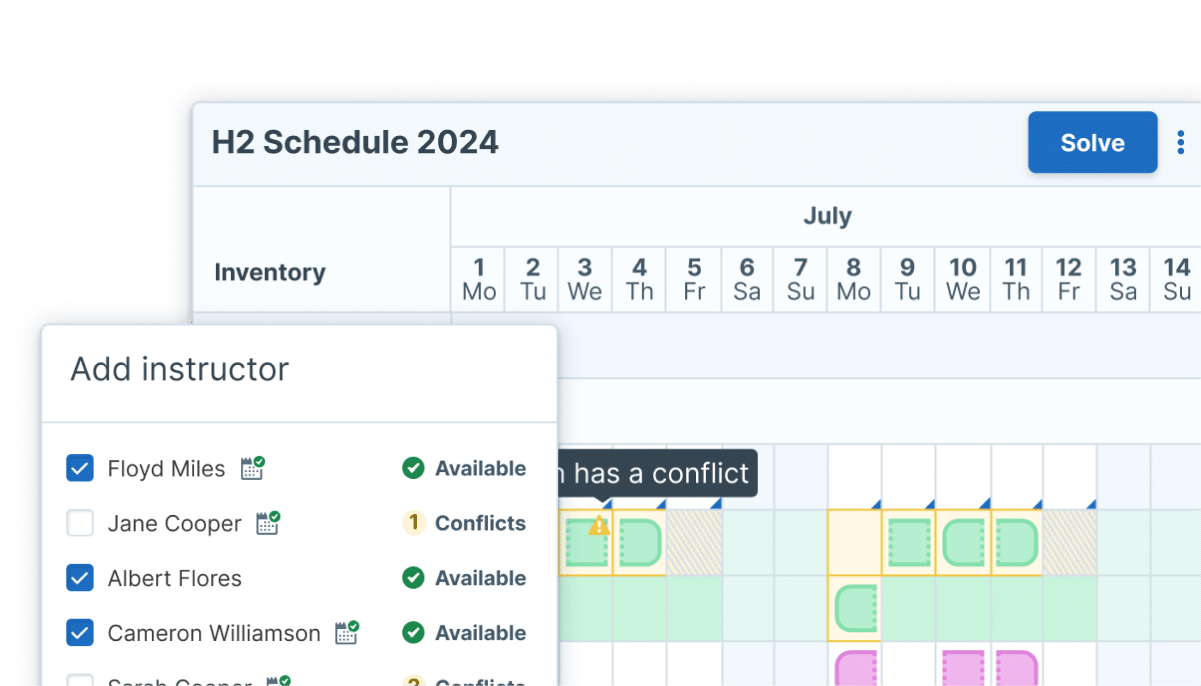Introduction
Since the beginning of 2020, change in enterprise business has been accelerating at an exponential rate.
Technological advances are increasing the rate at which disruptive forces, both positive and negative, impact society, markets, and regulatory requirements. As a result, organizations have to make decisions quicker, while relying on data-driven insights to provide more accuracy and relevancy to the critical pivot points that define organizational resilience
The intersection: mission-critical data and organizational resilience
Training sits at the intersection of the majority of pivotal inflection points, like workforce distribution, reskilling and upskilling to adapt on the fly, understanding how customers are responding to an increasingly digital world, and supply chain issues, to name a few.
The rapid change that is happening at these key inflection points requires more than just a reactive response.
How to navigate it with intentionality

Anticipating change and responding proactively is now an organizational imperative, and training leaders and teams possess the ability to provide the mission-critical data that can forecast where and how to adapt. Building a learning analytics blueprint is a good place to start.
Most enterprise leaders expect disruption to become a part of the ‘new normal,’ but they face significant challenges in being prepared long-term, and accessing data-driven decision making that can combat this new reality. A lot of that data sits within the grasp of the training team and maximizing it has significant implications for the future of business.
Catalyzing change
Operational efficiency, rapid decision-making, and scalability.

The challenges inherent in this new reality we’ve all become accustomed to will continue to complicate strategic planning and the accuracy of decision making unless technological changes are made to support operational efficiency and the rapidity with which decisions can be made. We’ve seen this type of change before in business – and also in culture – whereby long-standing principles have faced the need to change.
In 1842, the word blueprint originated. It refers to a print of white lines on blue paper and was widely used for over 100 years to rapidly produce specification drawings, while providing the foundation for architectural design. Now, the process itself is obsolete, giving way to CAD, software applications, and more advanced forms of printed architectural specifications.
This change happened because less expensive printing methods and, eventually, digital displays made room for better and more accessible representations of the elements of a blueprint. However, the word itself is still widely used, and a popular representation of how the foundation for advanced operations is built. Often the basis for the way we do things, even it’s become popularized, paves the way for innovation and optimized response to long-standing ideologies. In this way, our traditional understanding of data capture in training, and its reach, is evolving.
This transformation is all in service of efficiency and scale. Being able to handle unexpected changes in training volume, delivery formats, and your organization’s market requires a different outlook on the impact of training data and how we operationalize its reach to inform the effective use of training resources.
Let’s explore the key elements of that change by dissecting the traditional four types of data analytics – descriptive, diagnostic, prescriptive, and predictive analytics – and how they’ve informed adaptations in training ROI reporting.
Descriptive analytics
The foundation of Learning Analytics architecture.

Descriptive analytics provide the foundation for your learning analytics architecture. These are the training metrics that rely on a historical outlook of the performance of your training program, and the basis by which further data inferences are informed downstream. Think of this data as the structural pieces your training ROI leans on, but not the decor by which your impact on the business is measured.
The very basis of this data relies on its accessibility. By its nature, it is the easiest to capture and share with key stakeholders and has long been a staple of L&D reporting. It certainly informs learning analytics, but activity metrics alone can’t tell the complete story of training’s impact on the business, as leaders in training are fully aware.Accessible and relevant
While not inherently capable of demonstrating training ROI, descriptive analytics are still important because they’re easily traced back to quantitative and qualitative responses, represent seat time, attendance records, completion rates, and achievements – among other metrics – and provide a high-level outlook on the performance of training programs. This is the data that innovation and optimization hinges upon, where the journey from outdated learning analysis to modern training business intelligence begins.Solid, visible, points in time easily traced back to occurring events
You’re probably already running reports to capture activity metrics like learner attendance and satisfaction, and you might even be running reports on demographical data across departments and locations; however, even descriptive analytics can go deeper for many training teams.

With a deeply connected training operations platform, like Administrate, it’s possible to bring learning and business data together in one interface and begin to transform the impact of training reports.
Next level reports
Here are some additional reports your training team could be running to capture deeper insight into descriptive analytics:
- Cohort-driven reporting. Role or population context of learners versus how behaviors and trends perform at a population level to identify gaps and opportunities.
- Course cost correlation. Cost-per-learner implications of course activity to monitor how and where your training ROI emerges.
With the proper learning analytics structural design, it’s possible to access this crucial context and begin to trace the data correlation between separate events. For example, you may have a course that performs really well with one group of learners, but the same course doesn’t perform well with a separate group of learners. Why? With the foundation of descriptive analytics, you can begin to pinpoint inflection points and take the next step toward diagnostic analytics, where potential answers to investigative queries are formed.
In this article, discover how to leverage your activity metrics in more a correlated fashion, so you can transform the way your organization makes decisions.Explore how to move beyond activity metrics
Diagnostic analytics
Drilling down to reveal correlating results.

Diagnostic analytics drill down into the data of descriptive analytics to unearth correlations between why training outcomes happen and what those outcomes could mean for your organization moving forward. Identifying variables and rates of change is a good place to start. Going back to the example above: why did the same L&D content that performed well with one group not perform well with another? Did the job roles change amongst the two learner cohorts? Were there any differences in the location of the training, or the format in which it was delivered? Did the same instructor lead both instances?
With diagnostic analytics, training leaders can start to identify trends and insights in their data that have broader implications on organizational objectives and business goals.
Drilling down into activity metrics to identify why something happened is how training leaders begin to tell the story of what their data means to the organization at large. In order for this story to be quickly disseminated to key stakeholders, and for the implications of what the data means to be impactful, the questions asked about training data must necessarily be practical and direct. When pinpointed questions are asked about what happened, it’s easier to incorporate the answers into a plan to reach a desired future state. This is how training leaders get closer to diagnosing, with more accuracy, the correlation between training outcomes and business objectives.Functional and pinpointed
Let’s say you’ve identified an issue with your onboarding program. As expected, you start to ask questions about where the gaps are. Where are people losing engagement most frequently? What concepts are they having trouble understanding? Who are the instructors responsible for various learning milestones? As you reveal the answers to these questions, you can dive deeper and begin to uncover answers to more complex queries. What percentage of learners are applying the concepts from a key onboarding course to their daily work environment? Is there a practical element missing in some of your critical onboarding courses? How are learners performing when they have a practical learning experience involved? As more questions are asked over time, the picture of training analysis becomes clearer, and iterative responses to the story behind the data become more complex.Perceived results based on reoccuring or correlating events
Your training team is likely running reports on certificates, achievements, and their expiration date, version control on course content, and the timeliness of training as it relates to learner performance outcomes. Yet, there are some additional reports that correlate the “why” behind results to pivotal business information even further.

Next level training reports
Pressing the inquiry to the discovery of business trends is where training leaders begin leading the business:
- Business KPI outcomes mapped to training of individual contributors. How did their training (or lack of learning) contribute to the success or failure of the goal?
- Correlation versus causation of training impact. Where did training of key populations not only meet the demands of the business but demonstrably contribute to success?
Maximizing understanding of diagnostic analytics is a key step in transforming the reach and breadth of the impact learning analytics can have on organizational objectives. This further layer of optimization on activity metrics reveals a window of opportunity into forecasting change with data.
The organization was onboarding rapidly and also losing talent at an alarming rate during a period of high growth. They pinpointed the issues and reversed the trend.How a maritime manufacturer dramatically reduced employee turnover
Predictive analytics
Forecasting the future with trends in the present.

Predictive analytics takes the trends identified in diagnostic analytics and further applies mathematical models to them to forecast likely future scenarios that could happen. There is also an element at play here that relies on key PESTLE indicators, and external developments in your organization’s industry, as well as the training industry as a whole. Leveraging data from your internal operations and factoring those against external indicators of change or innovation allows you to begin forecasting how to innovate and optimize your training operations and initiatives.
The trouble is, the average enterprise training team relies on 9-12 different systems to manage their training operations, with each system representing yet another disconnected data source. So, managing disparate data sources and the influx of incoming external data in an efficient and transformative way is difficult, yet all the more important and we’ll dive into that a bit below.
Regardless, with predictive analytics, training leaders can begin to lead their organizations in identifying why, where, and how to focus efforts to maintain a competitive advantage. And, the training team’s ability to do so is mission-critical, as “70% of CEOs and senior executives do not have confidence in their organizations’ ability to adapt and transform in response to disruptive events”.
Training is at the epicenter of change’s reverberating impact on business. Enterprise learning and development teams are uniquely positioned to lead change, and predictive analytics provide a compass for navigating an unforeseen future with greater certainty. Modeling training metrics for future needs requires the ability to connect disparate data sources with one another and to external drivers, so you can maximize your ability to iterate. A sustainable learning tech stack that can support growth and interconnectivity, and multipurpose training initiatives that reveal data on dynamic variables is paramount. This means data that has longevity backed by correlating relational outputs that stand the test of time – data supported by multifunctional training initiatives that reach across departments and learning objectives that align with the agile ways in which learners engage with training.Sustainable and multifunctional
When you reach the stage of implementing predictive analytics, your data will take on a new limitation or challenge – depending on how you look at it – and you may ask yourself the question: how far can we extend the links between training outcomes and business objectives? You’ll bump up against the obstacles defined by tech limitations, the complexity of your data pipeline, and the speed at which you can process and define the meaning of your data. That last point is the key indicator here: does your access to data afford you the ability to infer incoming change, quickly, or are you constantly relying on outdated processes to reveal what you can expect in the future, based on the trends you’ve revealed? This is the efficiency of training operations is more important than ever, and why leading training teams are beginning to redefine their learning tech stack with a platform approach.The extent of data limits as they relate to your industry and business goals
Many training teams have made it to the plotted location right before this fundamental state of an exponential operating environment, but not into and beyond it. When you make it to this state, your data and the questions you use to interrogate it should rely on rapidity more than anything else – the data you intake should quickly inform a future you can anticipate.
For example, this could entail reports on the forecast of your onboarding program and what this means for your business moving forward, regulatory changes on the horizon, and even the ways in which you reach learners in an ever-changing digital environment. Yet, there are reports that ask more from your training data as well.

Next level training reports
There is a revolution occurring in learning tech, whereby training is being served the same level of analysis traditionally reserved for Marketing, Sales, and Finance teams via learning tech that operates on the foundation of a platform. Here is an example of a report that is defining this new era in training operations:
Real-world models. Often, training teams are forced to rely upon contingency plans for fixed scenarios in an uncertain time. This means problems are expected, but probably not solved. Utilizing AI-powered analysis that considers resources, capacity, and costs can provide immediate insight into needs and opportunities that arise.
Leading training teams are taking a critical step toward dynamic reporting by deeply connecting learning and business systems in one data pipeline, thereby limiting the complexity of accessing multiple sources for mission-critical data. By further utilizing AI, and automation within this training software, training teams are beginning to forecast future scenarios with even more accuracy.
Architecting a more comprehensive reporting structure often happens in stages. In this article, explore the organizational attributes of each stage in the training business intelligence journey, and the levers to pull to reach new milestones.The Path to better reporting
Prescriptive analytics
Modeling the future with data patterns

The most advanced analytics stage for training business intelligence is prescriptive analytics. If predictive analytics is the process of formulating insights on trends and forecasting what could happen in multiple scenarios based on those trends, then prescriptive analytics goes a step further. Prescriptive analytics applies patterns to those trends and seeks to model the most likely outcomes as a result of what’s being revealed in the patterns. From there, the best possible actions are suggested for optimization in response to the data. Essentially, if predictive analytics compile the trends that tell us what could happen, then prescriptive analytics seek to inform us of what should happen.
With prescriptive analytics, it’s possible to tell more than just a training ROI story; in fact, it’s possible to define what ROI can look like for your organization in the future. This is where the longevity and transparency of data, and learning analytics modeling come into play. Instead of spending hours poring over spreadsheets, pivot tables, and leveraging manual workarounds to connect your data sources, your exponential operating environment is intaking the data from all sources while a powerful reporting engine makes it possible to quickly build training reports that showcase how to adapt. Ultimately, we never know when our daily lives will be abruptly disrupted. However, with clear visibility into the intersecting correspondence of multiple data sources, it’s possible for training leaders to craft calculated responses to perceived threats and changes, and design enduring training initiatives to support organizational resilience.Enduring and transparent
A learning tech infrastructure is the scaffolding to a learning analytics architecture. Without clear and concise connections between the disparate tools in your operating environment, it’s impossible to leverage the operational efficiency necessary for effortless data modeling. For example, for a training team operating in a manufacturing company, the coordination of complex training logistics supports rapid decision-making. So, this training team needs to be able to quickly surmise how resources are allocated across locations, the shift schedules of employees, the classroom space, the certificates up for renewal, and any of the special equipment needed for training. If they’re able to coordinate this complexity with one scheduling tool, then making decisions about the employees who need critical training in the future to help the company remain competitive becomes that much easier.Optimized operational efficiency leads to seamless data-driven decision daking
True training business intelligence isn’t only about the data points that demonstrate the response to training, or the qualitative understanding of how learners engage with training. A true learning analytics architecture relies on the symbiotic relationship between the tech used in the operating environment and the complexity of delivering training to support organizational objectives. By understanding the correlation between these two ideas, we can begin to craft the ways in which we pull data from the operating environment in order to demonstrate the valuable role training plays in reaching key organizational objectives.

For example, your training team may already be building reports to demonstrate the implications of future regulatory changes and the investment needed to prepare learners for a perceived compliance eventuality. Or, you may be leveraging environmental factors and organizational trajectory to identify the content that needs to be created or renewed to support learners in remaining agile and adaptable. Here are some other examples of prescriptive analytics reports:
Next Level Training Reports
- Training Surge Forecast: What training will be needed when to matriculate new hires from on-boarding to optimal performance, and how long will that take to render positive business impact?
- Resource Impact Forecast: If your training resources (equipment, instructors, etc) increases by X, what will the measurable impact be to the business based on that change? If a bottleneck is removed, how will business outcomes change?
A prescriptive data framework can empower the autonomy of your training team, and allow you to make business intelligent decisions with more speed, accuracy, and relevancy. Instead of choosing to rely solely on the wisdom of the crowd, prescriptive analytics embolden the insights received from the crowd, and expert staff perspective, to further drive sustainable growth and success for your organization.
Reclaiming your learning tech infrastructure to better inform data-driven intelligence is possible. In this guide, explore the three must-have attributes of learning tech infrastructure, and how they impact organizational resilience in the short and long term.The importance of a durable learning tech stack
Future-proof
How to future-proof training operations with Learning Analytics.

Ultimately, a learning analytics architecture is all about remaining future-proof to disruption and change. Each of the four types of analytics we just walked through provides an increased level of interaction with training data, and makes new insights available to executive leadership in enterprise business.
Here are three ways you can use the insights revealed throughout the process of crafting a learning analytics architecture to support your organization’s future-proof actions.
1.
Empowering the Bottom Line of Organizational Change
In enterprise business, an organization’s ability to rapidly and flexibly adapt how it positions its offering in the marketplace is the key to success. This is why training teams are uniquely set up to support the bottom line of organizational change. Training teams are capable of revealing new ways to monetize product offerings, reskilling and upskilling key employees to impact growth in new ways, and determining value statements from the ways in which customers are interacting with your products and services.
2.
Demonstrating Training ROI in the Present, and Defining Future ROI
Training ROI has historically been one of the most difficult numbers to quantify. However, with new learning tech, it’s now becoming even more accessible. More importantly, it’s not only possible to demonstrate ROI in the present, but also lead conversations around how organizations should adapt to an uncertain future, an ROI that catalyzes change on an exponential scale. With prescriptive analytics, training leaders are starting to lead business change and identify anticipated opportunities where training metrics play a pivotal role.
Designing data for decision support
3.
Aligning Training Outcomes to Business Objectives to Lead Resilience
One of the critical expansion areas learning tech is undergoing is its ability to deeply integrate with existing proprietary, legacy learning systems, and also – most critically – business systems. With this transformation in learning tech comes new and exciting opportunities founded on the principle that training should always be deeply connected to the goals and objectives the organization has labeled as key indicators of success, and ultimately, market durability. By including data from critical business systems like Finance tracking software, HRIS tools, and LXP software alongside training data, the training function is now catalyzing organizational resilience.
If you’re interested in seeing a lot of these conceptual arguments in action and curious as to how other CLOs are approaching these fundamental conversations internally, check out a recent webinar with Bill Magagna, the Global Head of Digital Infrastructure at Siemens Healthineers.Establishing a true north for your learning analytics blueprint
